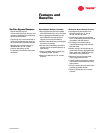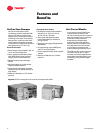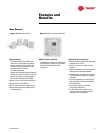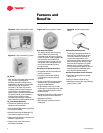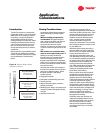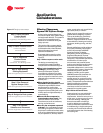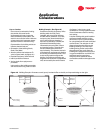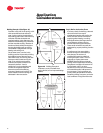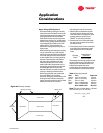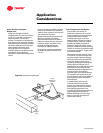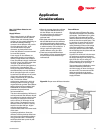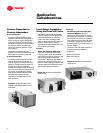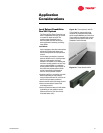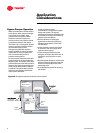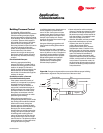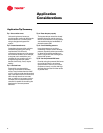
VAV-PRC003-EN 17
Application
Considerations
Table 1. Diversity example
Calculating thermal zone diversity:
1. Determine the instantaneous peak
(or block) load for the thermal zone.
This information is output from load
analysis software such as Trane
TRACE
®
or manually calculated.
2. Calculate the sum of the peak loads
for each of the comfort zones within
the thermal zone.
3. The diversity factor is then calculated
by dividing the instantaneous peak
load value by the sum of the peak
loads.
The heating and cooling equipment will
never be called upon to provide more
capacity than was determined by the
instantaneous peak load value.
Consequently, the equipment capacity
can be reduced by the diversity factor.
Step 4. Sizing HVAC Equipment
Once the building heating and cooling
loads are known and the thermal zones
have been determined, the heating and
cooling equipment can be selected.
Each thermal zone requires a separate
heating and cooling unit. As discussed
earlier, unitary zoning systems typically
use packaged DX rooftop units or DX
split systems. These systems are
offered as heating and cooling units or
heat pumps.
When selecting the heating and cooling
unit for a thermal zone, load diversity
within the zone should be considered to
minimize equipment size and therefore
reduce system first cost and operating
expense. Load diversity is defined as
the ratio of the instantaneous peak
loads (block load) to the sum of the
peak loads within the thermal zone. In
recognizing load diversity, the designer
acknowledges that all areas of the
thermal zone will not require maximum
cooling or heating at the same time.
While using diversity may reduce the
size of the HVAC unit, the zone
ductwork, dampers, and diffusers must
be sized for the individual zone peak
loads. The main trunk duct may be sized
based on the HVAC unit airflow.
Diversity
Factor
=
Instantaneous
Peak Load
Sum of Peaks
Zone Time Peak Load
Interior 3 p.m. in mid-July 7.5 tons
North 5 p.m. in mid-July 3.0 tons
East 9 a.m. in June 2.5 tons
South 4 p.m. in November 4.0 tons
West 5 p.m. in September 2.5 tons
Sum of Peak Loads 19.5 tons
Note: The sum of blocks loads = 17.5 tons
and occurs at 5 p.m. in mid-July.
______
19.5
Diversity = 17.5 = 90%
Figure 20. Diversity example
North Zone
East Zone
West Zone
Interior Zone
South Zone
Wedge Zone
Building Perimeter
Glass
Windows



